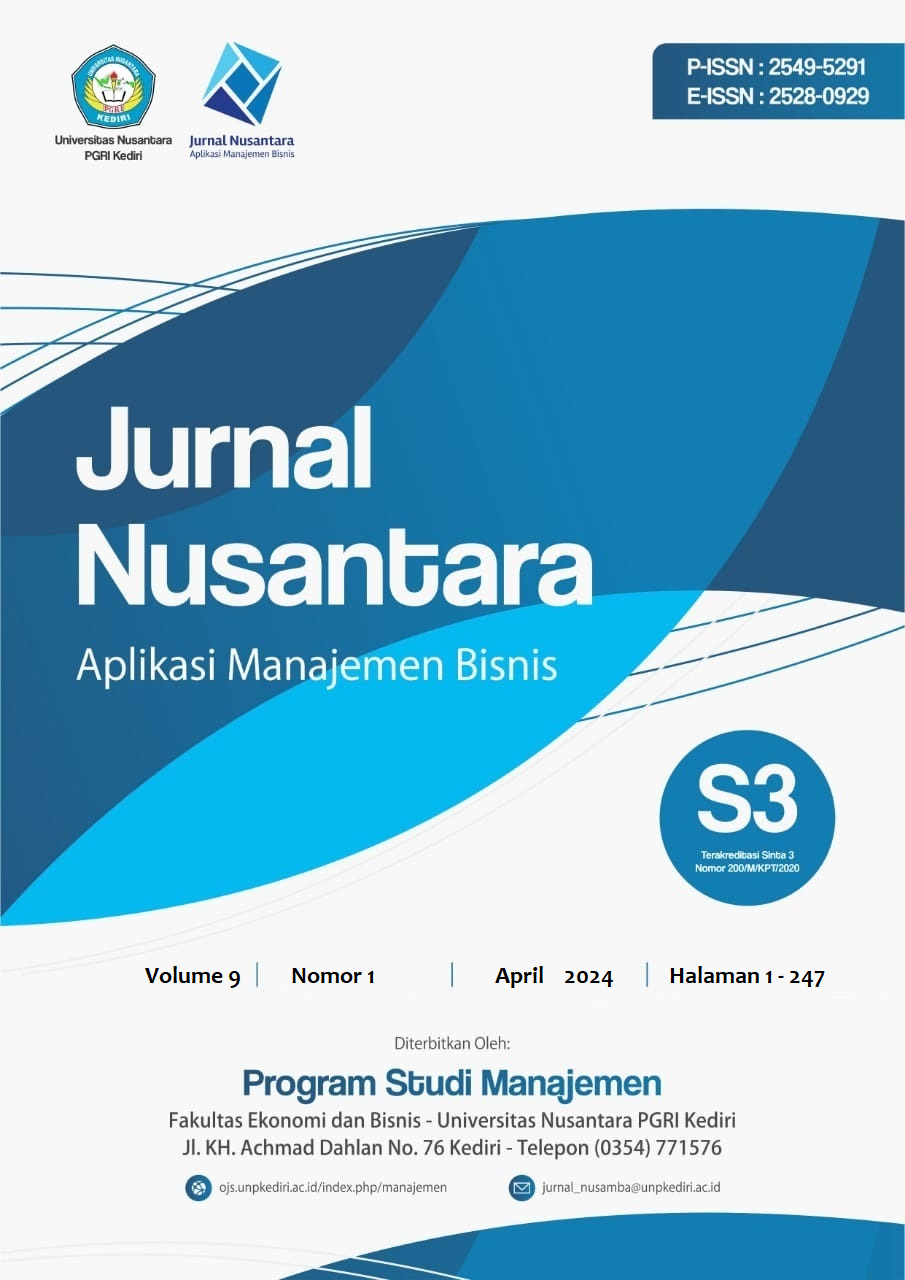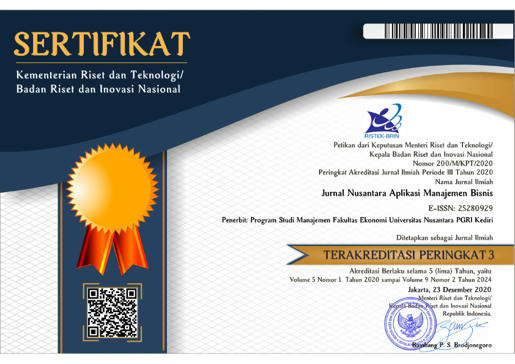Work Stress, Job Burnout, and Turnover Intention among Micro, Small, and Medium Finance Company’s Employee
DOI:
https://doi.org/10.29407/nusamba.v9i1.20008Keywords:
employee turnover, turnover intention, work stress, job burnoutAbstract
Research aim: The purpose of this study is to find efforts to reduce the turnover intention of an employee by examining the factors that become antecedents of the turnover intention of an employee, namely work stress and job burnout.
Design/Methode/Approach: Quantitative approach with survey method, using regression analysis (path analysis) and quantitative data (from questionnaires).
Finding: This study reveals that work stress and job burnout positively influence turnover intention, with job burnout mediating the relationship between work stress and turnover intention, while life stressors, feeling ineffective in dealing with others at work, and actively seeking a new job are identified as the most influential factors.
Theoretical contribution/Originality: The theoretical contribution of this research lies in its special emphasis on the influence of perceived outcomes of stress and the importance of harmonious relationships between coworkers in reducing the impact.
Practitioner/Policy implication: Concerning the turnover intention of their employee to decrease the turnover of employees by reducing stress levels and reducing job burnout in employees.
Research limitation: This study only used samples from branch offices in Java Island, as well as its examination of only three variables (Work Stress, Job Burnout, and Turnover Intention). We recommend further research to use a wider sample.
Downloads
References
Abramson, A. (2022). Burnout and stress are everywhere. Monitor Psychology. Vol. 53 No. 1, 72.
Basak, E., Ekmekci, E., Bayram, Y., & Bas. Y. (2013). Analysis of Factors That Affect the Intention to Leave of White-collar Employees in Turkey Using Structural Equation Modelling”. Proceedings of the World Congress on Engineering and Computer Science 2013 Vol II, 2013, 23-25. San Francisco, USA.
Beehr, T.A., Jex, S.M., Stacey, B.A. & Murray, M.A. (2000). Work stressors and co-worker support as predictors of individual strain and job performance. Journal of Organizational Behavior, Vol. 21, 391-405.
Blau G.J. & Lunz M. Testing the incremental effect of professional commitment on intent to leave one's professional beyond the effects of external, personal and work-related variables. Journal of Vocational Behavior. 1998;52:260–269.
Frese, M. (1999). Social support as a moderator of the relationship between work stressors and psychological dysfunctioning: a longitudinal study with objective measures. Journal of Occupational Health Psychology, Vol. 4, 179-92.
George, J.M. & Jones, G.R. (2012) Understanding and Managing Organizational Behavior. Upper Saddle River, NJ: Prentice Hall, 249.
Gibson, J.L, Ivancevich, J.M., Donnelly, Jr. J.H. & Konopaske, R. (2012). Organizations: Behavior, Structure, Processes. New York McGraw-Hill, 205.
Griffeth, R.W., Hom, P.W. & Gaertner, S. (2000). A meta-analysis of antecedents and correlates of employee turnover: update, moderator test, and research implications for the next millennium. Journal of Management, Vol. 26, 463-88.
Halawi, A.H. (2014). Stimuli and Effect of the Intention to Leave the Organization. European Scientific Journal. Vol.1 ISSN: 1857 – 7881 (Print) e - ISSN 1857- 7431.
Hasin, H.H. & Omar, N.H. (2017). an Empirical Study on Job Satisfaction, Job-Related Stress and Intention to Leave Among Audit Staff in Public Accounting Firms in Melaka. Journal of Financial Reporting & Accounting, 21-39.
Hellriegel, D. & Slocum, Jr., J. W. (2011). Organizational Behavior. Mason, OH: South Western, Cengage Learning, pp. 224-230.
Jin, Y.Y., Noh, H., Shin, H. & Lee, S.M. (2015). A Typology of Burnout Among Korean Teachers. Asia-Pacific Education Respitory, 24(2), 309–318.
Kim, H & Stoner, M. (2008). Burnout and Turnover Intention Among Social Workers: Effects of Role Stress, Job Autonomy and Social Support. Administration in Social Work Journal, Vol 32, 5-25. https://doi.org/10.1080/03643100801922357
Ladelsky, L.K. and Lee, T.W. (2022), "Effect of risky decision-making and job satisfaction on turnover intention and turnover behavior among information technology employees", International Journal of Organizational Analysis, Vol. ahead-of-print No. ahead-of-print. https://doi.org/10.1108/IJOA-10-2022-3465
Lavrova,K. & Levin, A.(2006). Burnout Syndrome: Prevention and Management Handbook for workers of harm reduction programs, 6-57.
Lee, K., Carswell, J.J. & Allen, N. (2000). A meta-analytic review of occupational commitment: relations with person- and work-related variables, Journal of Applied Psychology, Vol. 85, 799-811.
Lofquist, L., & Dawis, R. (1969). Adjustment to Work, Appleton Century Crofts, New York.
Maslach, C., & Leiter, M. P. (2007). Burnout. 358-371. Elsevier Inc. All rights reserved.
Maslach, C. & Leiter, M. P. (2016). Understanding the burnout experience: recent research and its implications for psychiatry. World Psychiatry. doi: 10.1002/wps.20311
Ongori, H. (2007). A review of the literature on employee turnover. African Journal of Business Management, 1(3), 49-54.
Poghosyan, L., Aiken, L. & Sloane, D. (2009). Factor Structure of the Maslach Burnout Inventory: An Analysis of Data from Large Scale Cross-Sectional Surveys of Nurses from Eight Countries. International Journal of Nursing Studies, Vol 46, 894-902 https://doi.org/10.1016/j.ijnurstu.2009.03.004
Scanlan, J.N. & Still, M. (2019). Relationships between burnout, turnover intention, job satisfaction, job demands and job resources for mental health personnel in an Australian mental health service. BMC Health Services Research, 19:62. https://doi.org/10.1186/s12913-018-3841-z
Schaufeli, W.B. & Peeters, M.C.W. (2000). Job Stress and Burnout Among Correctional Officers: A Literature Review. International of Stress Management Journal, Vol 7 (1),19-47.
Schermerhorn, J.R., Hunt, J.G. Osborn, R.N. & Uhl-Bien, M. (2010). Organizational Behavior. Hoboken, NJ: John Wiley and Sons, pp. 37-39.
Wagner III, J. A. & Hollenbeck. J. R. (2010). Organizational Behavior: Securing Competitive Advantage. London: Routledge, pp. 107-108
World Health Organization (2019),
Downloads
Published
Issue
Section
License
Authors who publish with this journal agree to the following terms:
- Copyright on any article is retained by the author(s).
- The author grants the journal, the right of first publication with the work simultaneously licensed under a Creative Commons Attribution License that allows others to share the work with an acknowledgment of the work’s authorship and initial publication in this journal.
- Authors are able to enter into separate, additional contractual arrangements for the non-exclusive distribution of the journal’s published version of the work (e.g., post it to an institutional repository or publish it in a book), with an acknowledgment of its initial publication in this journal.
- Authors are permitted and encouraged to post their work online (e.g., in institutional repositories or on their website) prior to and during the submission process, as it can lead to productive exchanges, as well as earlier and greater citation of published work.
- The article and any associated published material is distributed under the Creative Commons Attribution-ShareAlike 4.0 International License












